Ambidexterity is the ability to use both the right and left hand equally well. When referring to objects, the term indicates that the object is equally suitable for right-handed and left-handed people. When referring to humans, it indicates that a person has no marked preference for the use of the right or left hand.

In baseball, the pitcher is the player who throws ("pitches") the baseball from the pitcher's mound toward the catcher to begin each play, with the goal of retiring a batter, who attempts to either make contact with the pitched ball or draw a walk. In the numbering system used to record defensive plays, the pitcher is assigned the number 1. The pitcher is often considered the most important player on the defensive side of the game, and as such is situated at the right end of the defensive spectrum. There are many different types of pitchers, such as the starting pitcher, relief pitcher, middle reliever, lefty specialist, setup man, and the closer.
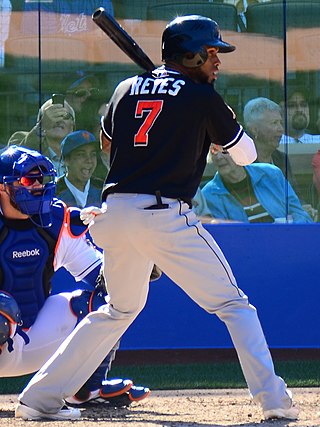
In baseball, a switch hitter is a player who bats both right-handed and left-handed, usually right-handed against left-handed pitchers and left-handed against right-handed pitchers, although there are some exceptions.
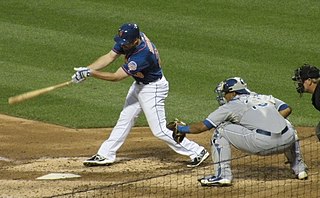
Catcher is a position in baseball and softball. When a batter takes their turn to hit, the catcher crouches behind home plate, in front of the (home) umpire, and receives the ball from the pitcher. In addition to this primary duty, the catcher is also called upon to master many other skills in order to field the position well. The role of the catcher is similar to that of the wicket-keeper in cricket.

In baseball and softball, a relief pitcher or reliever is a pitcher who pitches in the game after the starting pitcher has been removed because of fatigue, ineffectiveness, injury, or ejection, or for other strategic reasons, such as inclement weather delays or pinch hitter substitutions. Relief pitchers are further divided informally into various roles, such as closers, setup men, middle relief pitchers, left/right-handed specialists, and long relievers. Whereas starting pitchers usually throw so many pitches in a single game that they must rest several days before pitching in another, relief pitchers are expected to be more flexible and typically pitch in more games with a shorter time period between pitching appearances but with fewer innings pitched per appearance. A team's staff of relievers is normally referred to metonymically as a team's bullpen, which refers to the area where the relievers sit during games, and where they warm-up prior to entering the game.
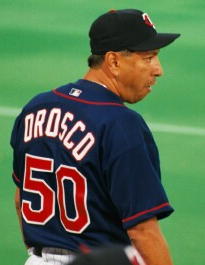
In baseball, a left-handed specialist is a relief pitcher who throws left-handed and specializes in pitching to left-handed batters, weak right-handed batters, and switch-hitters who bat poorly right-handed. Because baseball practices permanent substitution, these pitchers frequently pitch to a very small number of batters in any given game, and rarely pitch to strictly right-handed batters. Most Major League Baseball (MLB) teams have several left-handed pitchers on their rosters, at least one of whom is a left-handed specialist. A left-handed specialist is sometimes called a LOOGY, coined by John Sickels, and may be used pejoratively.

In baseball, the batting order or batting lineup is the sequence in which the members of the offense take their turns in batting against the pitcher. The batting order is the main component of a team's offensive strategy. In Major League Baseball, the batting order is set by the manager, who before the game begins must present the home plate umpire with two copies of his team's lineup card, a card on which a team's starting batting order is recorded. The home plate umpire keeps one copy of the lineup card of each team, and gives the second copy to the opposing manager. Once the home plate umpire gives the lineup cards to the opposing managers, the batting lineup is final and a manager can make changes only under the Official Baseball Rules governing substitutions. If a team bats out of order, it is a violation of baseball's rules and subject to penalty.

Throughout the history of baseball, the rules have frequently changed as the game continues to evolve. A few common rules most professional leagues have in common is that four balls is a base on balls, three strikes is a strikeout, and three outs end a half-inning.

In baseball, a pinch hitter (PH) is a substitute batter. Batters can be substituted at any time while the ball is dead ; the manager may use any player who has not yet entered the game as a substitute. Unlike basketball, American football or ice hockey, and in a similar way to association football, baseball does not have a free substitution rule and thus the replaced player is not allowed back into that game. The pinch hitter assumes the spot in the batting order of the player whom he replaces. Pinch hitters are commonly used to replace a weak hitter or to gain a platoon advantage.
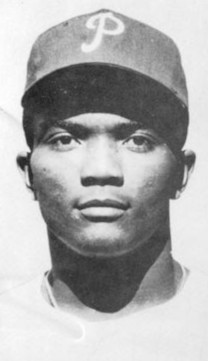
Andrés Antonio "Tony" González was a Cuban professional baseball outfielder, who played in Major League Baseball (MLB) for the Cincinnati Reds (1960), Philadelphia Phillies (1960–1968), San Diego Padres (1969), Atlanta Braves (1969–1970), and California Angels (1970–1971).
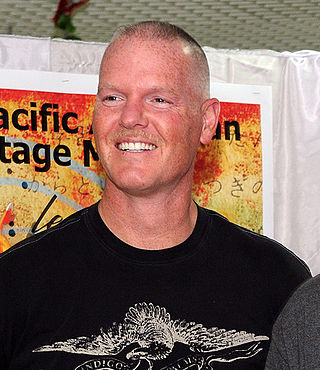
Jeffrey Allan Nelson is an American sports broadcaster and former baseball relief pitcher who played 15 years in Major League Baseball (MLB). He batted and threw right-handed. Nelson had two stints with the New York Yankees, the team with whom he won four World Series championships. Nelson retired from playing in 2007 after signing a minor league contract with the Yankees.
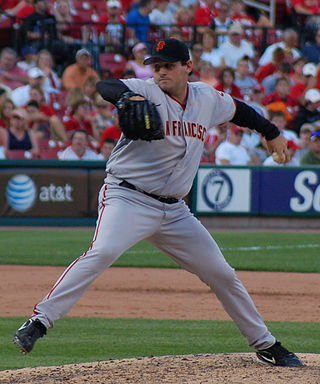
Steven James Kline is an American college baseball coach for the IUP Crimson Hawks. He is also a former professional relief pitcher who pitched for the Cleveland Indians, Montreal Expos, St. Louis Cardinals, Baltimore Orioles, and San Francisco Giants of Major League Baseball (MLB) over an 11-year career. Kline attended West Virginia University, where he played college baseball for the Mountaineers.
A platoon system in baseball or American football is a method for substituting players in groups (platoons), to keep complementary players together during playing time.

Greg Allen Harris is an American former professional baseball pitcher, who played in Major League Baseball (MLB) for 15 years, 1981–1995. Harris pitched in 703 career games, starting 98. He pitched for eight different teams, including the San Diego Padres when they lost the 1984 World Series to the Detroit Tigers in five games.
Pat McMahon is an American former college and professional baseball coach who currently works in the New York Yankees' organization.

In baseball, a switch-pitcher is an ambidextrous pitcher who is able to pitch with either the right or left hand from the pitcher's mound.
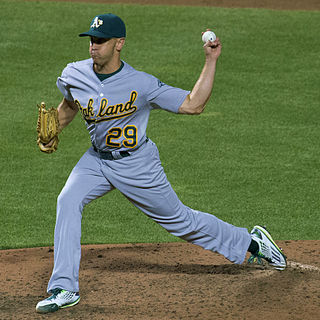
Patrick Michael Venditte Jr. is an American former professional baseball pitcher. He played in Major League Baseball (MLB) for the Oakland Athletics, Toronto Blue Jays, Seattle Mariners, Los Angeles Dodgers, San Francisco Giants, and Miami Marlins. After attending Creighton University, Venditte was drafted by the New York Yankees in 2008. He signed with the Athletics as a free agent before the 2015 season and made his MLB debut that year.
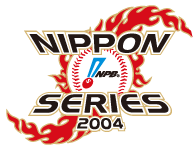
The 2004 Japan Series, the 55th edition of Nippon Professional Baseball's championship series, began on October 16 and ended on October 25, and matched the Pacific League playoffs winner Seibu Lions against the Central League Champion, Chunichi Dragons.
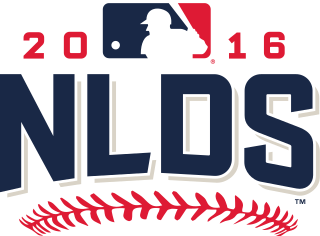
The 2016 National League Division Series were two best-of-five-game series to determine the participating teams in the 2016 National League Championship Series. The three divisional winners and a fourth team—the winner of a one-game Wild Card playoff— played in two series. FS1 and MLB Network carried all the games in the United States.

The 2022 Philadelphia Phillies season was the 140th season in the history of the franchise, and the 19th season for the Philadelphia Phillies at Citizens Bank Park. The Phillies went 87–75 during the regular season. They went on to win the National League pennant for the first time since 2009.



















